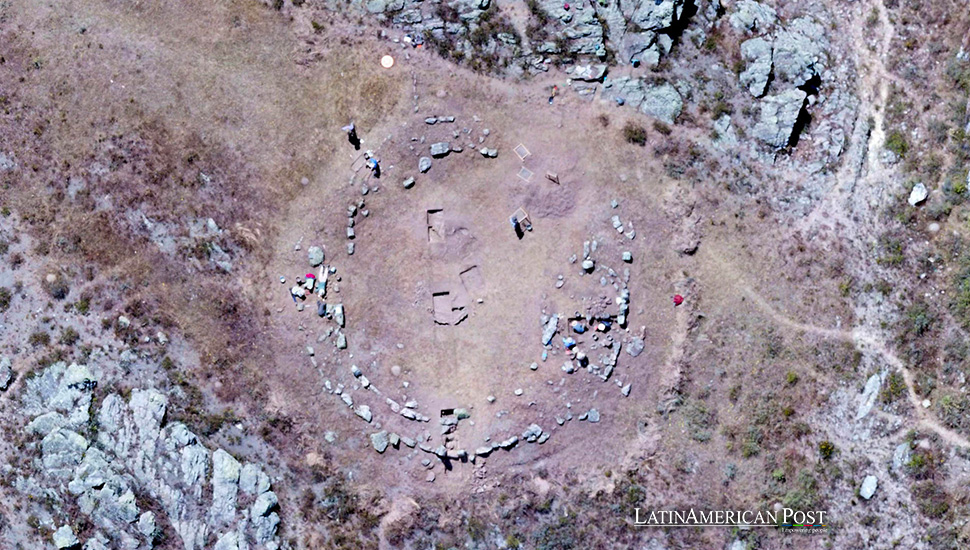Unveiling the Past: Peru’s 5,000-Year-Old Plaza Discovery Aligns with the Era of the Pyramids of Giza and Stonehenge

A monumental stone plaza dating back 5,000 years has been uncovered in Northern Peru’s Cajamarca region, standing as a contemporary to Egypt’s Pyramids of Giza and England’s Stonehenge, shedding new light on ancient ceremonial architecture in the Americas.
Ancient Marvels of Cajamarca: A 5,000-Year-Old Discovery Unveiled
In the northern reaches of Peru, within the storied region of Cajamarca, a groundbreaking discovery has emerged from the shadows of history. A monumental stone plaza, estimated to be 5,000 years old, has been unveiled, placing it in the same historical timeline as the Pyramids of Giza and the megalithic structure of Stonehenge. This finding, announced by the Ministry of Culture, marks a significant milestone in our understanding of ancient civilizations in Latin America, revealing a complex and sophisticated society that rivaled its contemporaries across the globe.
Radiocarbon dating has confirmed that this circular plaza belongs to the late Preceramic period, making it one of Peru’s earliest monumental and megalithic ceremonial architecture. The plaza, discovered by the Archaeological Research Project (PIA) Callacpuma, spans 18 meters in diameter and is defined by two concentric walls, each constructed from a single row of large stones. This design distinguishes it from other walls and structures at the Callacpuma archaeological site, also known as Cerro Shaullo. It underscores its significance as one of the first known circular plazas in the Andes.
Nestled between the districts of Baños del Inca and Llacanora, approximately 8.5 kilometers east of the city of Cajamarca and over 850 kilometers from Lima, this site encapsulates its builders’ ingenuity and spiritual depth. The radiocarbon dating indicates an occupation date roughly 5,000 years ago, aligning it chronologically with Stonehenge in England and the great pyramids of Giza in Egypt. This synchronicity across continents highlights a period of monumental construction that spans the globe, suggesting a widespread human impulse towards creating enduring structures for ceremonial purposes.
The researchers, led by archaeologists Patricia Chirinos Ogata and Jason L. Toohey from the American universities of California and Wyoming, respectively, along with a team of specialists including Melissa Murphy from the University of Wyoming, have proposed that this plaza served as a gathering and ceremonial site for the surrounding population. Evidence of pottery offerings, quartz crystal fragments, sodalite, anthracite, and unusual stone miniatures rarely found in residential areas support this theory.
Architectural Diversity: Unveiling the Complex Society
The Ministry of Culture’s report, based on samples from the 2018 season of the project, suggests that the area is home to various types of constructions, including platform mounds, domestic terraces, tombs, rock shelters, residential neighborhoods, a segment of the Inca Trail, potential fortifications, and 145 panels of rock art. This diversity of structures indicates a complex and highly organized society that engaged in a wide range of activities, from domestic life to ceremonial practices and possibly defense.
The PIA Callacpuma project, funded by the University of Wyoming and the National Science Foundation (NSF), includes a community engagement component to raise residents’ awareness of the historical importance of their region. This approach enriches the archaeological investigation and fosters a sense of stewardship and pride within the community, ensuring the preservation and appreciation of these ancient monuments for future generations.
Challenging Perceptions of Ancient Civilizations
This discovery in Peru is a testament to Latin America’s rich and varied tapestry of human civilization. Similar monumental structures have been found in other countries in the region, such as the ancient pyramids in Mexico, the sophisticated irrigation systems of the Nazca Lines in Peru, and the grand temples of Tikal in Guatemala. Each site contributes to our understanding of ancient American societies, their technological advancements, and their profound connection to the spiritual and natural worlds.
Also read: Decolonizing Museums is Peruvian Artist Sandra Gamarra’s Vision at the Venice Biennale
Uncovering the 5,000-year-old plaza in Cajamarca offers a unique window into the past, inviting comparisons and connections across continents and cultures. It challenges our perceptions of ancient civilizations and their capabilities, suggesting that the Americas were home to societies as complex, innovative, and spiritually profound as those in the Old World. As archaeologists continue to unearth the secrets of the past, discoveries like the Callacpuma plaza deepen our appreciation for the ingenuity and resilience of ancient peoples, reminding us of the shared human endeavor to create, celebrate, and commemorate through monumental architecture.





